

The Great Southern & Western Railway
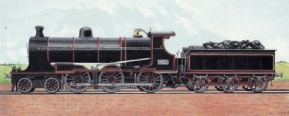
GREAT SOUTHERN & WESTERN RAILWAY EXPRESS LOCOMOTIVE No. 365
designed by Mr. R. Coey, Locomotive Superintendent.
ROSSLARE, on the Wexford coast, answers to Fishguard. The two harbours were built at the same time as the terminals of the short sea route, but boats for Waterford and boats for Cork also start from Fishguard for those who prefer a longer sea passage.
All three ports are served by the same railway, the Great Southern & Western, Ireland’s chief system. This extends from Dublin to Queenstown, from Rosslare to Kenmare on the south coast, and, on the west coast, from Valentia to Collooney near Sligo Bay, which is fairly to the north-
Inchicore, near Dublin, is the Great Southern & Western’s locomotive headquarters, and it has branch works at Limerick, for when it absorbed the Waterford & Limerick, and a reduction of expenses was provided for by removing the locomotive shops from there, the Limerick people got a clause into the Act retaining their works where they were, and thereby increased the working expenses instead of diminishing them. It owns about 300 engines, and among them are some excellent examples, powerful, serviceable, and smart, that would do credit to any company anywhere. Of its 8000 vehicles about a thousand are passenger coaches, many of them, such as are used in the Killarney express, being as good as those of the great lines in England, and none of them so bad as some of our survivals. Its carriages, like its engines and the miles of its track, number more than a third of the Irish total.
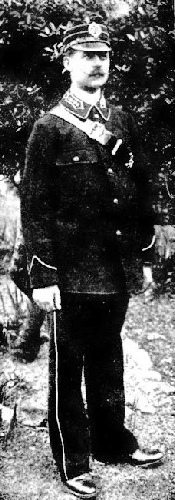
A GUARD OF THE GREAT SOUTHERN & WESTERN RAILWAY.
There are in Ireland about 3100 miles of railway, and of these the Great Southern & Western owns over 1100, the Great Northern and the Midland Great Western coming next with 1080 between them in almost equal shares. The English companies are beginning to take more interest in Irish matters in a practical way; not only have the Great Western gone to Rosslare, but the London & North Western have been the owners of the Dundalk & Greenore since 1873, and the Midland have an Irish section farther north.
The oldest railway in Ireland is the Dublin & Kingstown, authorised in 1831, now forming part of the Dublin & South Eastern, which also includes the once atmospheric Kingstown & Dalkey that led Brunel astray with regard to the South Devon. The Great Southern & Western was authorised as a line from Dublin to Cashel in 1844, and has grown by many amalgamations, for all Irish railways began in a small way and have had to struggle for their existence. They have to depend on passengers more than on merchandise, and the whole of them together do not carry so many passengers as the London, Tilbury & Southend, nor so many goods and minerals as the South Eastern & Chatham.

A BRAKE COMPOSITE
The gauge battle was just the sort of thing in which Irishmen would revel, and they chose their gauges to please themselves. The Ulster, for instance, completed twenty-
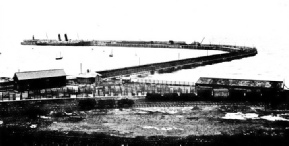
ROSSLARE HARBOUR
The Great Southern & Western ranges over the whole of the south country. It will take you to Waterford the historic and thriving; to Cork, the southern capital; to Kilkenny the ancient with its noble castle; to Killarney the beautiful in all weathers; to Valentia where the Atlantic cables go from; to Fenit on Tralee Bay; and to Limerick on the Shannon shore, the principal seaport of the west. Through Clare and Galway, Mayo and Sligo it goes, and it will run you up to Maryborough and Portarlington—and thence west to Athlone and Banagher and east to Dublin where it began.
Altogether it has some two dozen terminal stations, of which ten are on the coast; and wherever it goes the scenery is delightful, though it may not be desirable to contemplate it so hurriedly as is done by those who avail themselves of that wonderful excursion, run in connection with the Great Western, from Paddington to Killarney and back for a sovereign. Not only are there the lakes and hills around Muckross, there are Glengariff, the estuary of the Blackwater and that of the Shannon, Bantry Bay, the cliffs of Kerry and Clare, and the wilds of Connemara, all of which have their special admirers. Really there is no scenery, coast, river, lake, or mountain, finer than there is in Ireland.
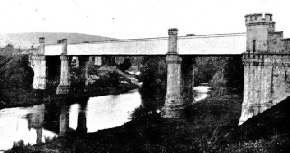
VIADUCT OVER THE RIVER SUIR, BETWEEN LIMERICK AND WATERFORD
Waterford, Cork, and Limerick are the commercial centres from which the Great Southern derives its revenue, all of them busy with farm and dairy produce and little else, for there is no ordinary merchandise worth mentioning. This absence of manufactures and of the necessity of men living away from their work is shown by the fewness of the season tickets; where there are no offices there are no seasons. There are more than six times as many seasons held in England as in Scotland, and more than nine times as many in Scotland as in Ireland. The Great Southern has but a few over a thousand ticket-
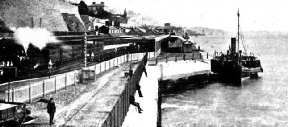
THE MAIL TENDER AT QUEENSTOWN
You can read more on
and
and
on this website.